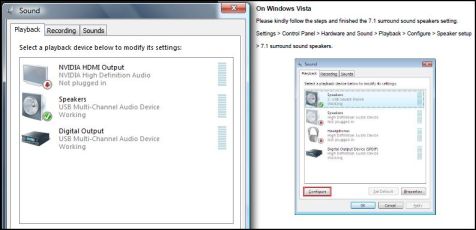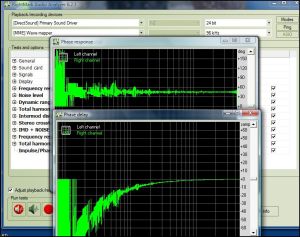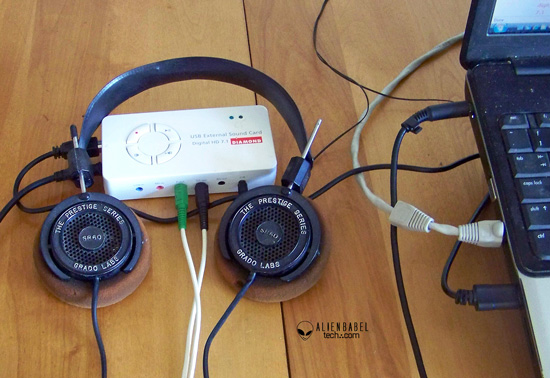Diamond’s Xtreme Sound External digital HD 7.1 Sound Card review
The Card, the Setup and the Software
As you can see from the last page, the device is well-protected for its journey to you. Here is the bundle outside of the box:
The Diamond Multimedia Xtreme Sound package comes packaged with the USB 2.0 device itself, a USB cable, the installation CD, and the quick start guide. Diamond products are found in retail stores so the box also advertises its features of dramatically improving notebook sound and its ability to use Dolby Digital Audio through S/PDIF. In fact you can find this device at WalMart for $39.99 Here is the back of the box; you don’t really need the quick-start guide. Karaoke, anyone? Yes! Just bring the mic. There is even a basic wav-editor included.
 And the end flaps give you a choice of reading in English or French:
And the end flaps give you a choice of reading in English or French:
 One end has the USB connector and a headphone out jack, the other end is for S/PDIF connections to your receiver for HTPC.
One end has the USB connector and a headphone out jack, the other end is for S/PDIF connections to your receiver for HTPC.
 The top of the device has record functions and also volume up and down. Two light will show its status. S/PDIF connectors are there for your receiver and the other end has a headphone jack next to the USB connector.
The top of the device has record functions and also volume up and down. Two light will show its status. S/PDIF connectors are there for your receiver and the other end has a headphone jack next to the USB connector.
The outputs are on the front and you have options to use them all simultaneously, or not – line-in, microphone-in, F-out for the front speakers in a 2.0 or 2.1 system, SS-out for the side speakers in a 4.0, 4.1 or 5.1 system, BS-out for the extra two side speakers of the 7.1 system and C/B for either a center speaker or a sub woofer.
You can also use this audio device together with Diamond’s BVU-1000 Multi-Media USB device that allows you to turn your notebook into a home theater PC (HTPC). It is just like watching your movies from the DVD/BlueRay player but using your notebook instead. Senior Editor David McOwen reviewed it here.
 It is absolutely ideal for using your notebook to watch Internet TV, HD YouTube videos and streaming NetFlix videos all on your big screen HDTV in full 7.1 audio.
It is absolutely ideal for using your notebook to watch Internet TV, HD YouTube videos and streaming NetFlix videos all on your big screen HDTV in full 7.1 audio.
Software
Installing this device is simple as it is plug and play. After Windows recognizes it, you will want to use the installation CD to install the driver
After you reboot your PC, you can set up Audacity which will give you some basic wav editing functions.
Check out your setup and make sure that you have the highest quality sound available. Here is my notebook’s integrated sound at the highest settings.
Next set up your speakers.
Here is the 5.1 configuration we chose on the left for our Cambridge Soundworks portable system plus an additional powered speaker for the center speaker. On the right, you can see what a 7.1 system looks like; you would need two additional speakers over the 5.1 setup.
Here is the kind of control we have how by using our sound card from looking at the .pdf on the CD.
 There is an equalizer available and each speaker’s level can be set independently. It’s remarkable that such an inexpensive device can do so much. Let’s now listen and hear how it sounds compared to the woefully inadequate integrated notebook sound.
There is an equalizer available and each speaker’s level can be set independently. It’s remarkable that such an inexpensive device can do so much. Let’s now listen and hear how it sounds compared to the woefully inadequate integrated notebook sound.
Listening Tests
For our listening tests, we used the well-recorded DVDs of Steely Dan and Carlos Santana that this editor is very familiar with. We also used 3 sound systems over several weeks to evaluate this Diamond Xtreme Sound USB external sound card. Of course, we ran the usual audio synthetic tests and naturally they showed some differences but they absolutely cannot tell you how either of the sound cards actually sound when playing music. That is what trained ears are for!
First up, we used our Cambridge quadraphonic system; it is 4.1 which means that only the Front-out and Side Speakers-out are used on the device’s front. We then decided to make our 4.1 into a 5.1 system by using the Diamond self-powered mini-speaker as a sixth speaker – for the center channel missing in Quad systems
Here it is set up with a center speaker – it works well for DVD movies and we tried several movies to test the positionality of the 5.1 sound over quadraphonic 4.1 sound.
The Diamond self-powered mini-speaker fit in surprisingly well with the other speakers after some adjustments in the control panel.
 As you can see in the above image, you have full control over that center speaker in the Diamond USB 7.1 control panel and can test and adjust each speaker individually. What was amazing was the sound of the music. It was set free from the stereo that the notebook’s integrated sound outputs and it became music that was enjoyable to listen to – not tiring as before on the same cheap system. It had never sounded so good as it had in many years since the Creative Audigy sound card succumbed to bad driver support and was retired.
As you can see in the above image, you have full control over that center speaker in the Diamond USB 7.1 control panel and can test and adjust each speaker individually. What was amazing was the sound of the music. It was set free from the stereo that the notebook’s integrated sound outputs and it became music that was enjoyable to listen to – not tiring as before on the same cheap system. It had never sounded so good as it had in many years since the Creative Audigy sound card succumbed to bad driver support and was retired.
Next up was the Klipsch Promedia v200 4.1 400W quad system. It sounded absolutely awful on the notebook’s sound card.
The difference is like night versus day with the Diamond Xtreme Sound 7.1 external USB sound card versus the notebook’s integrated sound chip. The bass that sounded so flabby on the notebook’s integrated sound now sounds tight and the highs are back necessitating a backing down on the treble! As with the cheap Cambridge system, it was tiring to listen to music before, but not any more thanks to Diamonds USB 7.1 Xtreme sound.
Of course, neither of these systems are “audiophile” and are not even close to high-end, yet the difference between the integrated notebook sound and the Diamond Sound card is obvious to a trained ear and even an inexperienced listener will appreciate music that is not tiring to listen to because of distortion. And finally, we had to break out our Grado SR60 headphones.
These headphones are well worn but still have the ability to reproduce remarkably clear and accurate audio. In this case, the deficiencies in the high and the lows of the notebook sound were clearly evident and were completely mitigated by the excellent sound of Diamond’s Xtreme Sound 7.1 USB Sound Card. This editor is enjoying his music again!
Conclusion
Pros
- Easy to install software, plug and play hardware and great flexibility in an inexpensive package
- Easy to hook up the USB cable and connections to the audio and/or receiver including S/PDIF
- Excellent sound with 8-speaker 7.1 audio possible from your notebook
- You can have an excellent HTPC system by adding a Diamond BVU1000 USB to HDMI adapter and use your notebook to watch Internet TV, YouTube and NetFlix on your big HDTV in full eight-speaker 7.1 surround.
Cons
- None whatsoever
If you want to listen to music on your notebook, I highly recommend this adapter. You will do your ears a big favor by dumping your notebook’s integrated sound and you have the option to use 8-speakers for 7.1 audio reproduction, for PC gaming as well as for recording and karaoke.
 The Diamond Multimedia Xtreme Sound 7.1 USB external Sound Card retails for $50 and is available at WalMart for $40 and I’ve seen sites offer it as low as $32.07 at Buy.com. That alone makes the Diamond Multimedia Xtreme Sound 7.1 device a great value! Enjoy your music again!
The Diamond Multimedia Xtreme Sound 7.1 USB external Sound Card retails for $50 and is available at WalMart for $40 and I’ve seen sites offer it as low as $32.07 at Buy.com. That alone makes the Diamond Multimedia Xtreme Sound 7.1 device a great value! Enjoy your music again!
Please join us in our Forums
Become a Fan on Facebook
Follow us on Twitter
For the latest updates from ABT, please join our RSS News Feed
Join our Distributed Computing teams
- Folding@Home – Team AlienBabelTech – 164304
- SETI@Home – Team AlienBabelTech – 138705
- World Community Grid – Team AlienBabelTech




















Writing in an article like this about yourself in the third person feels awkward, especially when it’s not consistent and one sentence later it’s back to in the first person. It would be better not to refer to yourself in the third person at all here. It makes for uncomfortable reading.
Of course, this is a wholly personal opinion, but it’s not without merit when it comes to the unwritten rules of writing.
The information itself was very much appreciated, though.
Take care.
I agree with dopdop… just say your first person piece in first person… this isn’t english class with its pretentious BS… there is nothing wrong with saying something in first person if it needs to be said.
I bought this card to output my audio to my 5.1 Speakers. Frankly they sound great. Impressive, even. I hooked it up to an old mac mini, which is then output to a 7 year old sony. I get great video from the mac. Now all I need to do is hook up the RCA Y cable from the TV to the line In on the sound card.
Nothing happens. I’ve been trying for over a month. Tech support is no help. I’m just tired of moving cables when I want to change program.
Am I offbase?
I think this is among the most important information for me. And i am glad reading your article. But should remark on few general things, The site style is ideal, the articles is really great : D. Good job, cheers
Nice read, I just passed this onto a colleague who was doing some research on that. And he just bought me lunch since I found it for him smile Thus let me rephrase that: Thanks for lunch! “Life is a continual upgrade.” by J. Mark Wallace.
Does this card support asio?
Will this USB card support on Samsung LED TV USB Port
I have SAMSUNG LED TV which has no Audio 3.5mm Jack. So, will this card support in my TVs USB Port as a Speakers